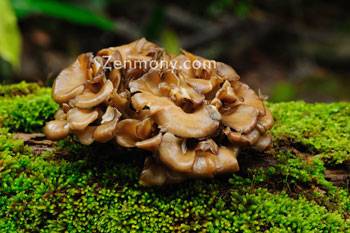| 2015 | APR | |||||||
| 2014 | JUL | OCT | DEC | |||||
| 2013 | JAN | FEB | APR | MAY | JUN | JUL | AUG | SEP |
| 2012 | SEP | OCT | NOV | DEC |
Maitake mushroom
 Maitake mushroom, commonly known in Japan under names such as mizunara, buna and shii, grows parasitically at the base of trees of the Fagaceae family such as Japanese beech. Maitake also lives on trees such as plum, persimmon, peach, apricot and others. Maitake used to be gathered in the woods but nowadays thanks to the advances in artificial cultivation technologies, one can buy maitake in almost any supermarket in Japan. Maitake (literally translated as "dancing mushroom") is said to have been named because it resembles "flying flower petals" or "a dancing nymph". In Chinese traditional medicine, maitake is known under the name of "raisho", and Chinese medical classics such as Bencao Gangmu (「本草綱目」) say that it is capable of stabilizing the nervous system and is effective against hemorrhoids. There are three close relatives of maitake:
Maitake mushroom, commonly known in Japan under names such as mizunara, buna and shii, grows parasitically at the base of trees of the Fagaceae family such as Japanese beech. Maitake also lives on trees such as plum, persimmon, peach, apricot and others. Maitake used to be gathered in the woods but nowadays thanks to the advances in artificial cultivation technologies, one can buy maitake in almost any supermarket in Japan. Maitake (literally translated as "dancing mushroom") is said to have been named because it resembles "flying flower petals" or "a dancing nymph". In Chinese traditional medicine, maitake is known under the name of "raisho", and Chinese medical classics such as Bencao Gangmu (「本草綱目」) say that it is capable of stabilizing the nervous system and is effective against hemorrhoids. There are three close relatives of maitake:
- Shiromaitake is similar to maitake, but its color is more white, the flesh is more delicate and it is not as crispy as maitake. Shiromaitake grows one week earlier in the year than maitake.
- Tonbimaitake has a strong smell and is generally not used in food or medicines.
- Choreimaitake. Its body tastes good but it can be gathered only in small amounts in its natural habitat. Choreimaitake has long been used in traditional Chinese medicine for its diuretic and antipyretic effects.
At present, maitake is cultivated artificially in Japan in several places such as Niigata, Nagano, Gunma, Shizuoka and elsewhere. The total amount of maitake cultivated in Japan was 14100 tons in 1994. Maitake is known to be exceptionally rich in minerals. When maitake ripens, its protein content lowers and its carbohydrate content increases. Ripe maitake mushrooms are 91% water. The rest is a combination of proteins, carbohydrates, plant fiber, vitamins and minerals. Maitake contains reasonable amounts of potassium, phosphor, magnesium, calcium, sodium, zinc, and other minerals. It contains bio-active substances including free-state organic acids: pyroglutamic acid, lactic acid, acetic acid, malic acid, citric acid, succinic acid, oxalic acid and fumaric acid. Malic acid comprises about 47–50% of the organic acid content. The diets of modern people are said to be generally lacking in minerals. Minerals are needed to control the main vital functions and sustain our health. By incorporating maitake and other mushrooms in the daily diet, one can replenish many of these minerals. More than other components, the polysaccharides contained in maitake mushrooms have captured the attention of many scientists. β-D-glucan, acidic xyloglucan, acidic heteroglucan, heteropolysaccharide-protein compound and other polysaccharides found in maitake have been proven to have a strong anti-tumor effect. Polysaccharides are contained not only in the body, but also in the mycelium of maitake mushrooms. Maitake mycelia (hyphae) contain important polysaccharides like β-D-glucan, glucomannan, manno-xyloglucan and also heteroglucan containing uronic acid. Maitake is one of the mushrooms that is capable of strengthening our immune system and it has a strong anti-tumor effect. Maitake research is not limited to Japan and is presently becoming more international. What has been commercialized is predominantly dried granules or extract. Please have a look at our agaricus blazei and other medicinal mushroom products.
Check out similar products here


